Employability Skills: Performance and Responsibilities in Healthcare
VerifiedAdded on 2021/06/15
|15
|5223
|59
Report
AI Summary
This report provides a comprehensive analysis of employability skills within the health and social care sector, focusing on self-reflection, performance evaluation, and professional development. It begins with a self-reflective summary identifying key responsibilities and performance objectives for a Registered Nurse, followed by a SWOT analysis to pinpoint strengths and weaknesses. The report then details an appraisal meeting scenario, addressing work-based problems and proposing solutions such as training and improved communication. Furthermore, it outlines a professional development plan with short-term, mid-term, and long-term goals, incorporating motivational techniques to enhance performance. The study concludes by emphasizing the importance of continuous improvement and the application of motivational strategies to achieve professional growth in the healthcare setting. Desklib offers this and other solved assignments to support students.
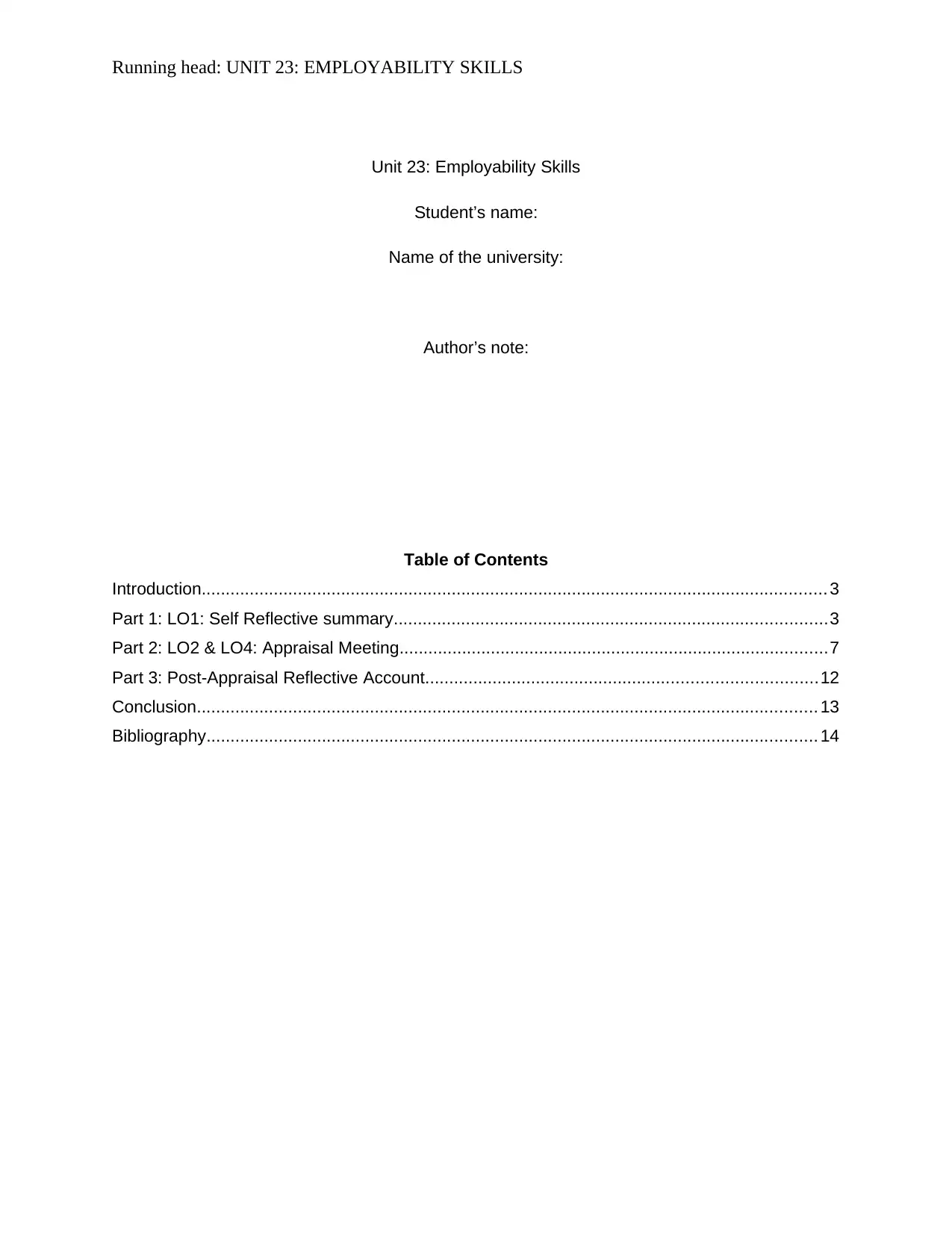
Running head: UNIT 23: EMPLOYABILITY SKILLS
Unit 23: Employability Skills
Student’s name:
Name of the university:
Author’s note:
Table of Contents
Introduction.................................................................................................................................. 3
Part 1: LO1: Self Reflective summary..........................................................................................3
Part 2: LO2 & LO4: Appraisal Meeting.........................................................................................7
Part 3: Post-Appraisal Reflective Account.................................................................................12
Conclusion................................................................................................................................. 13
Bibliography............................................................................................................................... 14
Unit 23: Employability Skills
Student’s name:
Name of the university:
Author’s note:
Table of Contents
Introduction.................................................................................................................................. 3
Part 1: LO1: Self Reflective summary..........................................................................................3
Part 2: LO2 & LO4: Appraisal Meeting.........................................................................................7
Part 3: Post-Appraisal Reflective Account.................................................................................12
Conclusion................................................................................................................................. 13
Bibliography............................................................................................................................... 14
Paraphrase This Document
Need a fresh take? Get an instant paraphrase of this document with our AI Paraphraser
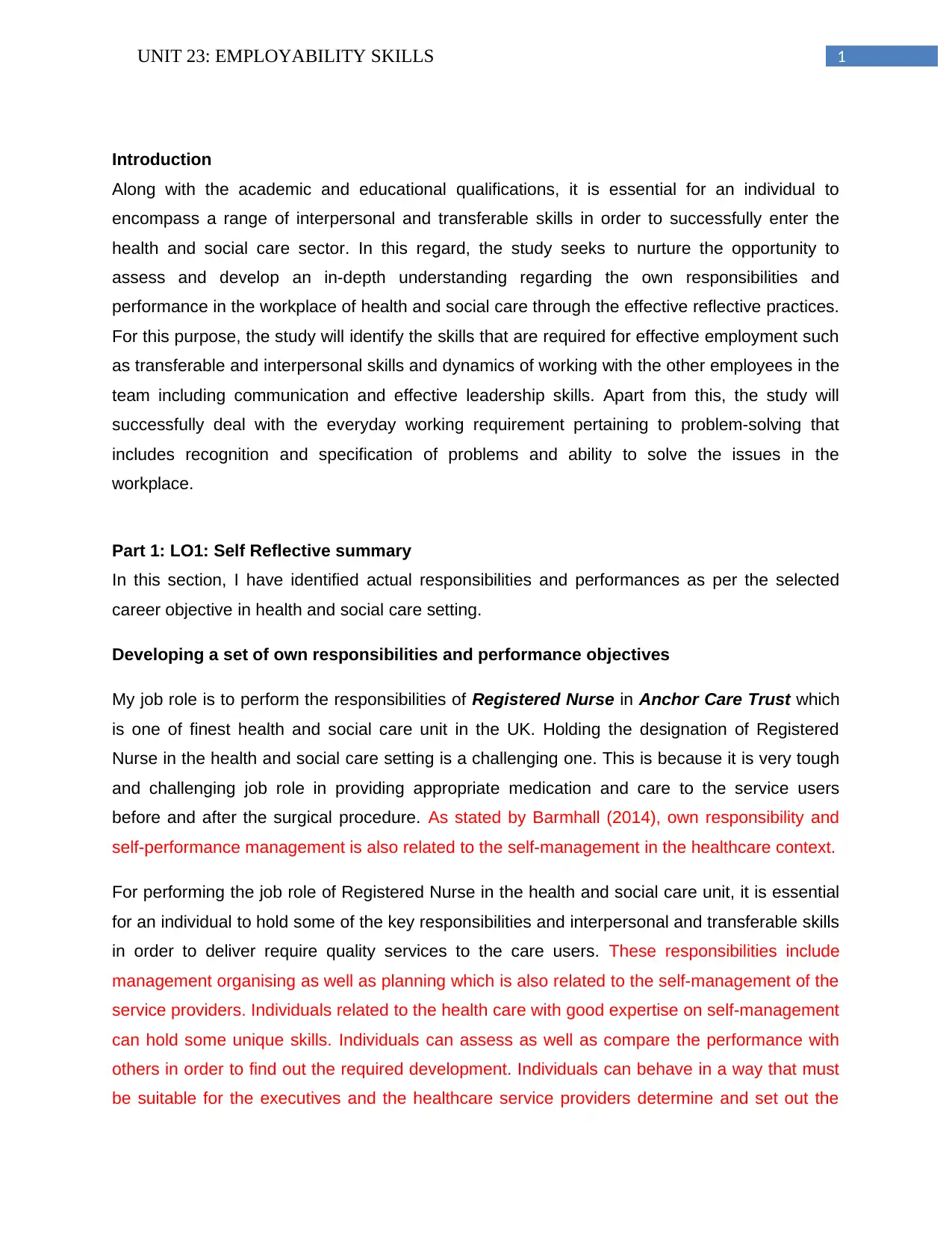
1UNIT 23: EMPLOYABILITY SKILLS
Introduction
Along with the academic and educational qualifications, it is essential for an individual to
encompass a range of interpersonal and transferable skills in order to successfully enter the
health and social care sector. In this regard, the study seeks to nurture the opportunity to
assess and develop an in-depth understanding regarding the own responsibilities and
performance in the workplace of health and social care through the effective reflective practices.
For this purpose, the study will identify the skills that are required for effective employment such
as transferable and interpersonal skills and dynamics of working with the other employees in the
team including communication and effective leadership skills. Apart from this, the study will
successfully deal with the everyday working requirement pertaining to problem-solving that
includes recognition and specification of problems and ability to solve the issues in the
workplace.
Part 1: LO1: Self Reflective summary
In this section, I have identified actual responsibilities and performances as per the selected
career objective in health and social care setting.
Developing a set of own responsibilities and performance objectives
My job role is to perform the responsibilities of Registered Nurse in Anchor Care Trust which
is one of finest health and social care unit in the UK. Holding the designation of Registered
Nurse in the health and social care setting is a challenging one. This is because it is very tough
and challenging job role in providing appropriate medication and care to the service users
before and after the surgical procedure. As stated by Barmhall (2014), own responsibility and
self-performance management is also related to the self-management in the healthcare context.
For performing the job role of Registered Nurse in the health and social care unit, it is essential
for an individual to hold some of the key responsibilities and interpersonal and transferable skills
in order to deliver require quality services to the care users. These responsibilities include
management organising as well as planning which is also related to the self-management of the
service providers. Individuals related to the health care with good expertise on self-management
can hold some unique skills. Individuals can assess as well as compare the performance with
others in order to find out the required development. Individuals can behave in a way that must
be suitable for the executives and the healthcare service providers determine and set out the
Introduction
Along with the academic and educational qualifications, it is essential for an individual to
encompass a range of interpersonal and transferable skills in order to successfully enter the
health and social care sector. In this regard, the study seeks to nurture the opportunity to
assess and develop an in-depth understanding regarding the own responsibilities and
performance in the workplace of health and social care through the effective reflective practices.
For this purpose, the study will identify the skills that are required for effective employment such
as transferable and interpersonal skills and dynamics of working with the other employees in the
team including communication and effective leadership skills. Apart from this, the study will
successfully deal with the everyday working requirement pertaining to problem-solving that
includes recognition and specification of problems and ability to solve the issues in the
workplace.
Part 1: LO1: Self Reflective summary
In this section, I have identified actual responsibilities and performances as per the selected
career objective in health and social care setting.
Developing a set of own responsibilities and performance objectives
My job role is to perform the responsibilities of Registered Nurse in Anchor Care Trust which
is one of finest health and social care unit in the UK. Holding the designation of Registered
Nurse in the health and social care setting is a challenging one. This is because it is very tough
and challenging job role in providing appropriate medication and care to the service users
before and after the surgical procedure. As stated by Barmhall (2014), own responsibility and
self-performance management is also related to the self-management in the healthcare context.
For performing the job role of Registered Nurse in the health and social care unit, it is essential
for an individual to hold some of the key responsibilities and interpersonal and transferable skills
in order to deliver require quality services to the care users. These responsibilities include
management organising as well as planning which is also related to the self-management of the
service providers. Individuals related to the health care with good expertise on self-management
can hold some unique skills. Individuals can assess as well as compare the performance with
others in order to find out the required development. Individuals can behave in a way that must
be suitable for the executives and the healthcare service providers determine and set out the
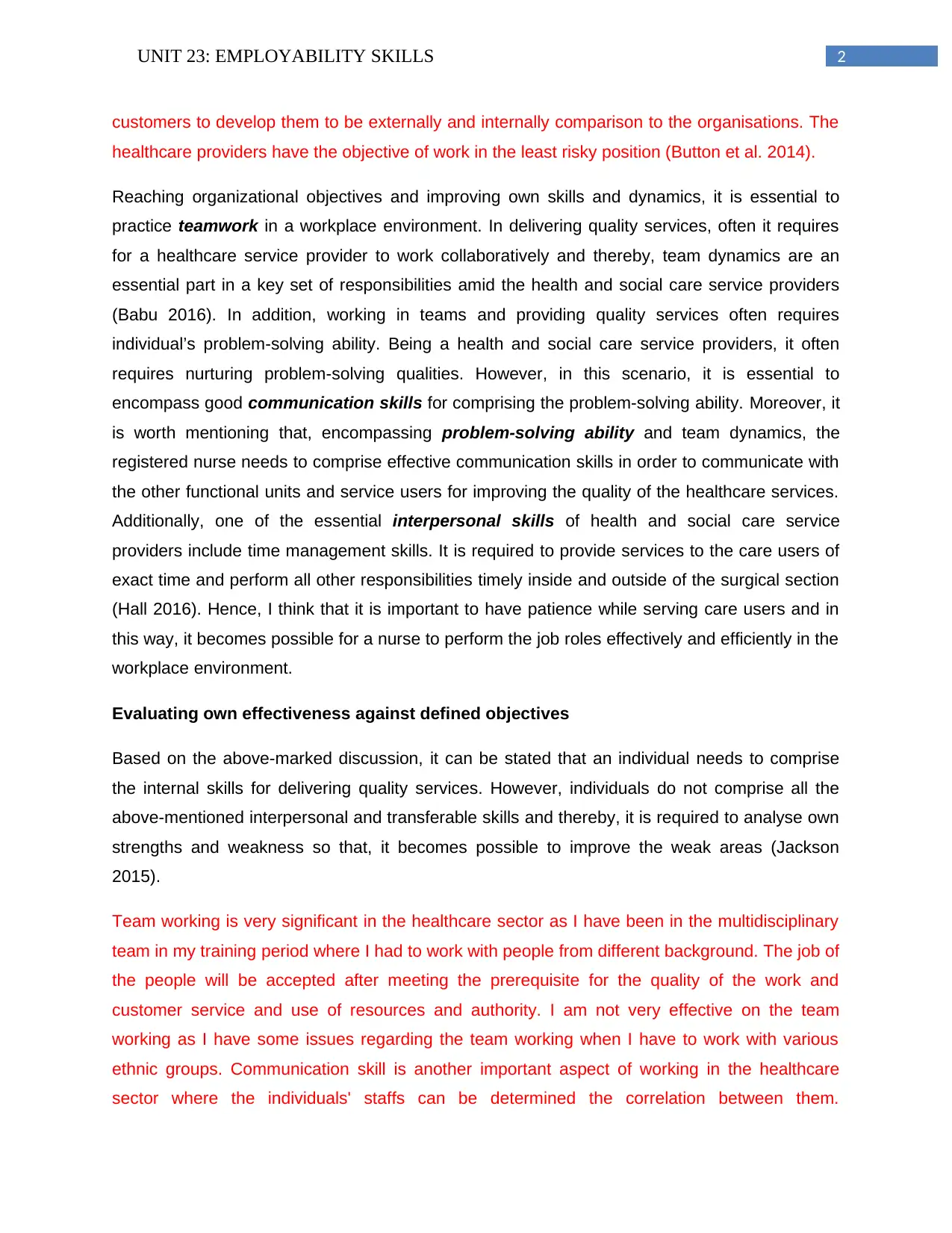
2UNIT 23: EMPLOYABILITY SKILLS
customers to develop them to be externally and internally comparison to the organisations. The
healthcare providers have the objective of work in the least risky position (Button et al. 2014).
Reaching organizational objectives and improving own skills and dynamics, it is essential to
practice teamwork in a workplace environment. In delivering quality services, often it requires
for a healthcare service provider to work collaboratively and thereby, team dynamics are an
essential part in a key set of responsibilities amid the health and social care service providers
(Babu 2016). In addition, working in teams and providing quality services often requires
individual’s problem-solving ability. Being a health and social care service providers, it often
requires nurturing problem-solving qualities. However, in this scenario, it is essential to
encompass good communication skills for comprising the problem-solving ability. Moreover, it
is worth mentioning that, encompassing problem-solving ability and team dynamics, the
registered nurse needs to comprise effective communication skills in order to communicate with
the other functional units and service users for improving the quality of the healthcare services.
Additionally, one of the essential interpersonal skills of health and social care service
providers include time management skills. It is required to provide services to the care users of
exact time and perform all other responsibilities timely inside and outside of the surgical section
(Hall 2016). Hence, I think that it is important to have patience while serving care users and in
this way, it becomes possible for a nurse to perform the job roles effectively and efficiently in the
workplace environment.
Evaluating own effectiveness against defined objectives
Based on the above-marked discussion, it can be stated that an individual needs to comprise
the internal skills for delivering quality services. However, individuals do not comprise all the
above-mentioned interpersonal and transferable skills and thereby, it is required to analyse own
strengths and weakness so that, it becomes possible to improve the weak areas (Jackson
2015).
Team working is very significant in the healthcare sector as I have been in the multidisciplinary
team in my training period where I had to work with people from different background. The job of
the people will be accepted after meeting the prerequisite for the quality of the work and
customer service and use of resources and authority. I am not very effective on the team
working as I have some issues regarding the team working when I have to work with various
ethnic groups. Communication skill is another important aspect of working in the healthcare
sector where the individuals' staffs can be determined the correlation between them.
customers to develop them to be externally and internally comparison to the organisations. The
healthcare providers have the objective of work in the least risky position (Button et al. 2014).
Reaching organizational objectives and improving own skills and dynamics, it is essential to
practice teamwork in a workplace environment. In delivering quality services, often it requires
for a healthcare service provider to work collaboratively and thereby, team dynamics are an
essential part in a key set of responsibilities amid the health and social care service providers
(Babu 2016). In addition, working in teams and providing quality services often requires
individual’s problem-solving ability. Being a health and social care service providers, it often
requires nurturing problem-solving qualities. However, in this scenario, it is essential to
encompass good communication skills for comprising the problem-solving ability. Moreover, it
is worth mentioning that, encompassing problem-solving ability and team dynamics, the
registered nurse needs to comprise effective communication skills in order to communicate with
the other functional units and service users for improving the quality of the healthcare services.
Additionally, one of the essential interpersonal skills of health and social care service
providers include time management skills. It is required to provide services to the care users of
exact time and perform all other responsibilities timely inside and outside of the surgical section
(Hall 2016). Hence, I think that it is important to have patience while serving care users and in
this way, it becomes possible for a nurse to perform the job roles effectively and efficiently in the
workplace environment.
Evaluating own effectiveness against defined objectives
Based on the above-marked discussion, it can be stated that an individual needs to comprise
the internal skills for delivering quality services. However, individuals do not comprise all the
above-mentioned interpersonal and transferable skills and thereby, it is required to analyse own
strengths and weakness so that, it becomes possible to improve the weak areas (Jackson
2015).
Team working is very significant in the healthcare sector as I have been in the multidisciplinary
team in my training period where I had to work with people from different background. The job of
the people will be accepted after meeting the prerequisite for the quality of the work and
customer service and use of resources and authority. I am not very effective on the team
working as I have some issues regarding the team working when I have to work with various
ethnic groups. Communication skill is another important aspect of working in the healthcare
sector where the individuals' staffs can be determined the correlation between them.
⊘ This is a preview!⊘
Do you want full access?
Subscribe today to unlock all pages.

Trusted by 1+ million students worldwide
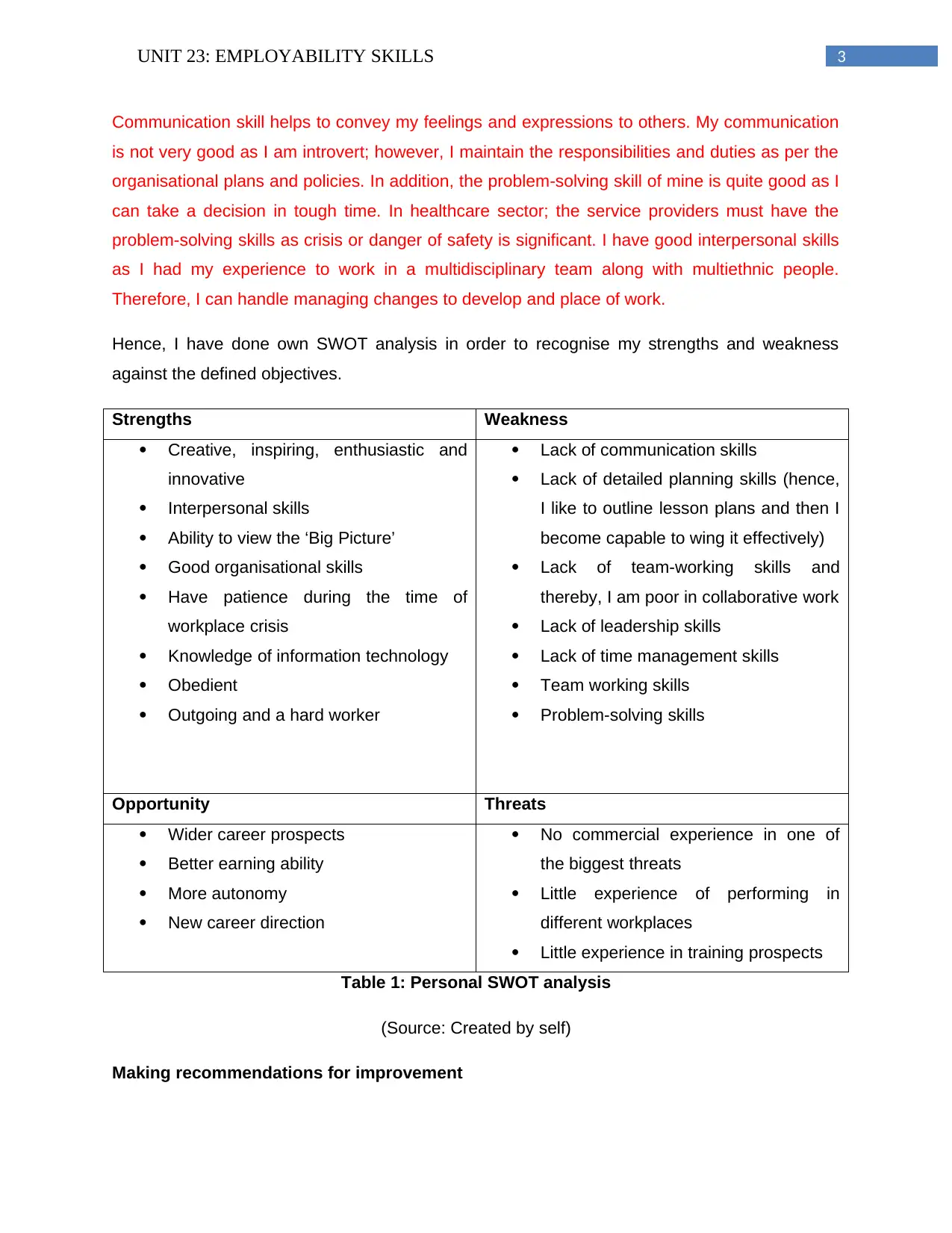
3UNIT 23: EMPLOYABILITY SKILLS
Communication skill helps to convey my feelings and expressions to others. My communication
is not very good as I am introvert; however, I maintain the responsibilities and duties as per the
organisational plans and policies. In addition, the problem-solving skill of mine is quite good as I
can take a decision in tough time. In healthcare sector; the service providers must have the
problem-solving skills as crisis or danger of safety is significant. I have good interpersonal skills
as I had my experience to work in a multidisciplinary team along with multiethnic people.
Therefore, I can handle managing changes to develop and place of work.
Hence, I have done own SWOT analysis in order to recognise my strengths and weakness
against the defined objectives.
Strengths Weakness
Creative, inspiring, enthusiastic and
innovative
Interpersonal skills
Ability to view the ‘Big Picture’
Good organisational skills
Have patience during the time of
workplace crisis
Knowledge of information technology
Obedient
Outgoing and a hard worker
Lack of communication skills
Lack of detailed planning skills (hence,
I like to outline lesson plans and then I
become capable to wing it effectively)
Lack of team-working skills and
thereby, I am poor in collaborative work
Lack of leadership skills
Lack of time management skills
Team working skills
Problem-solving skills
Opportunity Threats
Wider career prospects
Better earning ability
More autonomy
New career direction
No commercial experience in one of
the biggest threats
Little experience of performing in
different workplaces
Little experience in training prospects
Table 1: Personal SWOT analysis
(Source: Created by self)
Making recommendations for improvement
Communication skill helps to convey my feelings and expressions to others. My communication
is not very good as I am introvert; however, I maintain the responsibilities and duties as per the
organisational plans and policies. In addition, the problem-solving skill of mine is quite good as I
can take a decision in tough time. In healthcare sector; the service providers must have the
problem-solving skills as crisis or danger of safety is significant. I have good interpersonal skills
as I had my experience to work in a multidisciplinary team along with multiethnic people.
Therefore, I can handle managing changes to develop and place of work.
Hence, I have done own SWOT analysis in order to recognise my strengths and weakness
against the defined objectives.
Strengths Weakness
Creative, inspiring, enthusiastic and
innovative
Interpersonal skills
Ability to view the ‘Big Picture’
Good organisational skills
Have patience during the time of
workplace crisis
Knowledge of information technology
Obedient
Outgoing and a hard worker
Lack of communication skills
Lack of detailed planning skills (hence,
I like to outline lesson plans and then I
become capable to wing it effectively)
Lack of team-working skills and
thereby, I am poor in collaborative work
Lack of leadership skills
Lack of time management skills
Team working skills
Problem-solving skills
Opportunity Threats
Wider career prospects
Better earning ability
More autonomy
New career direction
No commercial experience in one of
the biggest threats
Little experience of performing in
different workplaces
Little experience in training prospects
Table 1: Personal SWOT analysis
(Source: Created by self)
Making recommendations for improvement
Paraphrase This Document
Need a fresh take? Get an instant paraphrase of this document with our AI Paraphraser
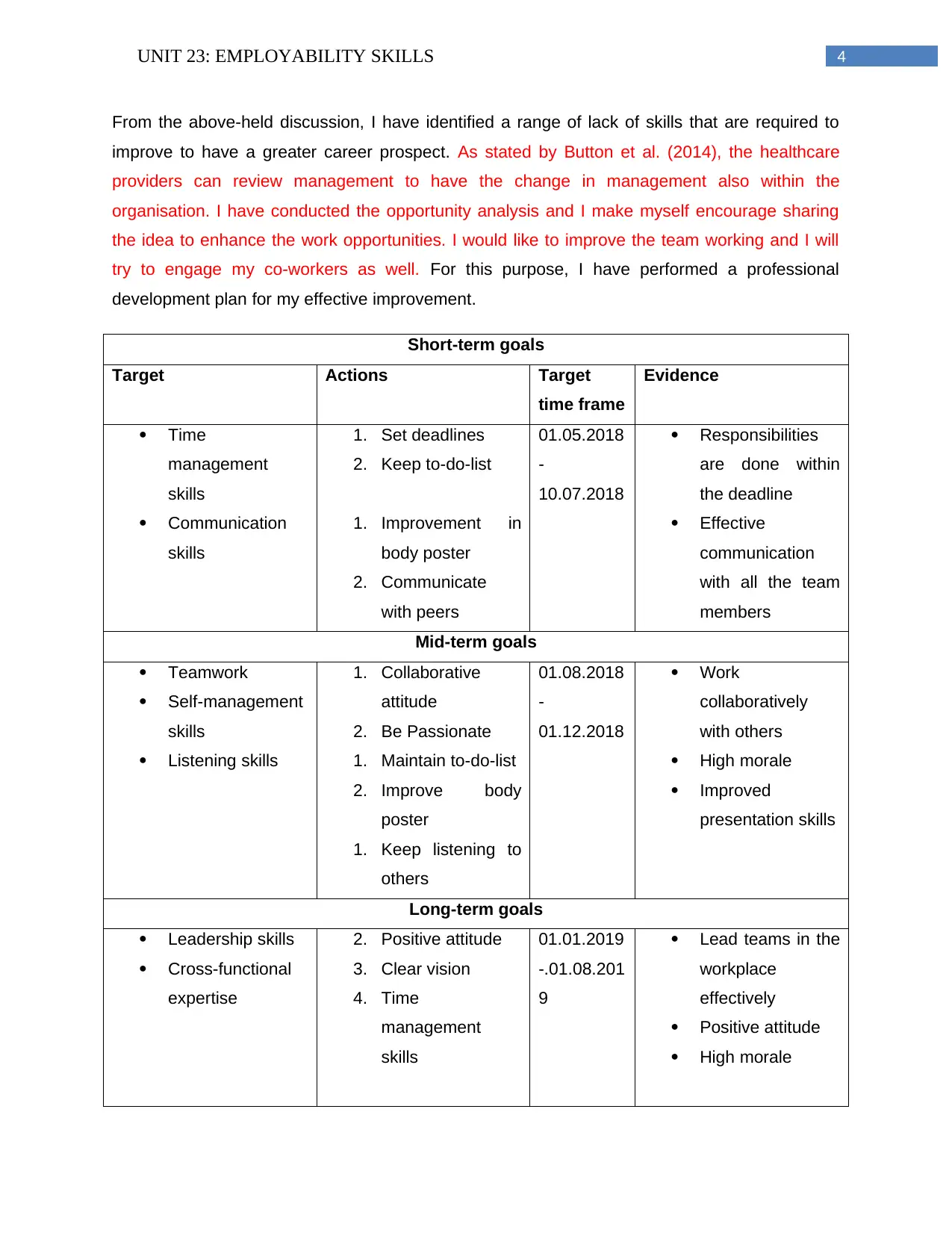
4UNIT 23: EMPLOYABILITY SKILLS
From the above-held discussion, I have identified a range of lack of skills that are required to
improve to have a greater career prospect. As stated by Button et al. (2014), the healthcare
providers can review management to have the change in management also within the
organisation. I have conducted the opportunity analysis and I make myself encourage sharing
the idea to enhance the work opportunities. I would like to improve the team working and I will
try to engage my co-workers as well. For this purpose, I have performed a professional
development plan for my effective improvement.
Short-term goals
Target Actions Target
time frame
Evidence
Time
management
skills
Communication
skills
1. Set deadlines
2. Keep to-do-list
1. Improvement in
body poster
2. Communicate
with peers
01.05.2018
-
10.07.2018
Responsibilities
are done within
the deadline
Effective
communication
with all the team
members
Mid-term goals
Teamwork
Self-management
skills
Listening skills
1. Collaborative
attitude
2. Be Passionate
1. Maintain to-do-list
2. Improve body
poster
1. Keep listening to
others
01.08.2018
-
01.12.2018
Work
collaboratively
with others
High morale
Improved
presentation skills
Long-term goals
Leadership skills
Cross-functional
expertise
2. Positive attitude
3. Clear vision
4. Time
management
skills
01.01.2019
-.01.08.201
9
Lead teams in the
workplace
effectively
Positive attitude
High morale
From the above-held discussion, I have identified a range of lack of skills that are required to
improve to have a greater career prospect. As stated by Button et al. (2014), the healthcare
providers can review management to have the change in management also within the
organisation. I have conducted the opportunity analysis and I make myself encourage sharing
the idea to enhance the work opportunities. I would like to improve the team working and I will
try to engage my co-workers as well. For this purpose, I have performed a professional
development plan for my effective improvement.
Short-term goals
Target Actions Target
time frame
Evidence
Time
management
skills
Communication
skills
1. Set deadlines
2. Keep to-do-list
1. Improvement in
body poster
2. Communicate
with peers
01.05.2018
-
10.07.2018
Responsibilities
are done within
the deadline
Effective
communication
with all the team
members
Mid-term goals
Teamwork
Self-management
skills
Listening skills
1. Collaborative
attitude
2. Be Passionate
1. Maintain to-do-list
2. Improve body
poster
1. Keep listening to
others
01.08.2018
-
01.12.2018
Work
collaboratively
with others
High morale
Improved
presentation skills
Long-term goals
Leadership skills
Cross-functional
expertise
2. Positive attitude
3. Clear vision
4. Time
management
skills
01.01.2019
-.01.08.201
9
Lead teams in the
workplace
effectively
Positive attitude
High morale
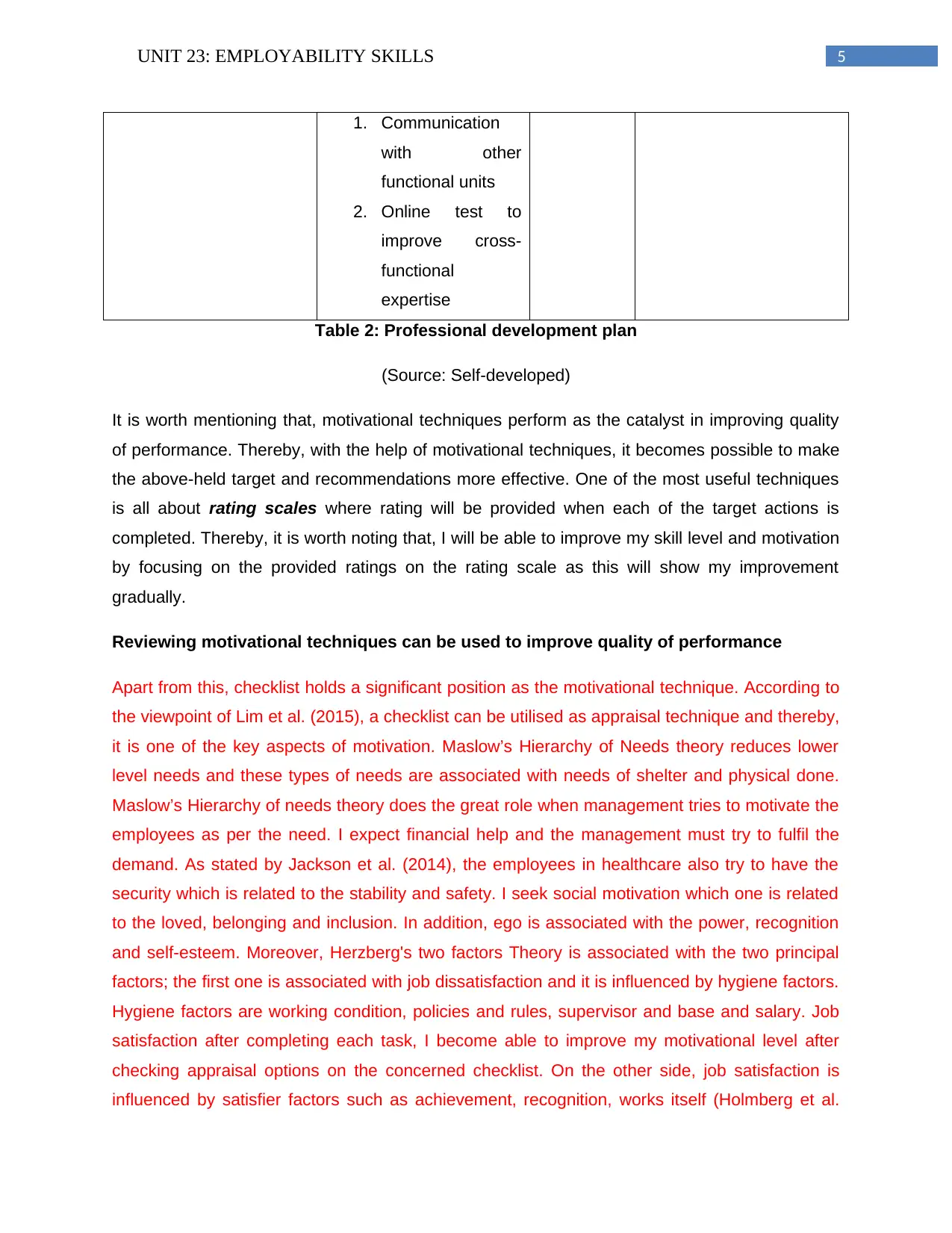
5UNIT 23: EMPLOYABILITY SKILLS
1. Communication
with other
functional units
2. Online test to
improve cross-
functional
expertise
Table 2: Professional development plan
(Source: Self-developed)
It is worth mentioning that, motivational techniques perform as the catalyst in improving quality
of performance. Thereby, with the help of motivational techniques, it becomes possible to make
the above-held target and recommendations more effective. One of the most useful techniques
is all about rating scales where rating will be provided when each of the target actions is
completed. Thereby, it is worth noting that, I will be able to improve my skill level and motivation
by focusing on the provided ratings on the rating scale as this will show my improvement
gradually.
Reviewing motivational techniques can be used to improve quality of performance
Apart from this, checklist holds a significant position as the motivational technique. According to
the viewpoint of Lim et al. (2015), a checklist can be utilised as appraisal technique and thereby,
it is one of the key aspects of motivation. Maslow’s Hierarchy of Needs theory reduces lower
level needs and these types of needs are associated with needs of shelter and physical done.
Maslow’s Hierarchy of needs theory does the great role when management tries to motivate the
employees as per the need. I expect financial help and the management must try to fulfil the
demand. As stated by Jackson et al. (2014), the employees in healthcare also try to have the
security which is related to the stability and safety. I seek social motivation which one is related
to the loved, belonging and inclusion. In addition, ego is associated with the power, recognition
and self-esteem. Moreover, Herzberg's two factors Theory is associated with the two principal
factors; the first one is associated with job dissatisfaction and it is influenced by hygiene factors.
Hygiene factors are working condition, policies and rules, supervisor and base and salary. Job
satisfaction after completing each task, I become able to improve my motivational level after
checking appraisal options on the concerned checklist. On the other side, job satisfaction is
influenced by satisfier factors such as achievement, recognition, works itself (Holmberg et al.
1. Communication
with other
functional units
2. Online test to
improve cross-
functional
expertise
Table 2: Professional development plan
(Source: Self-developed)
It is worth mentioning that, motivational techniques perform as the catalyst in improving quality
of performance. Thereby, with the help of motivational techniques, it becomes possible to make
the above-held target and recommendations more effective. One of the most useful techniques
is all about rating scales where rating will be provided when each of the target actions is
completed. Thereby, it is worth noting that, I will be able to improve my skill level and motivation
by focusing on the provided ratings on the rating scale as this will show my improvement
gradually.
Reviewing motivational techniques can be used to improve quality of performance
Apart from this, checklist holds a significant position as the motivational technique. According to
the viewpoint of Lim et al. (2015), a checklist can be utilised as appraisal technique and thereby,
it is one of the key aspects of motivation. Maslow’s Hierarchy of Needs theory reduces lower
level needs and these types of needs are associated with needs of shelter and physical done.
Maslow’s Hierarchy of needs theory does the great role when management tries to motivate the
employees as per the need. I expect financial help and the management must try to fulfil the
demand. As stated by Jackson et al. (2014), the employees in healthcare also try to have the
security which is related to the stability and safety. I seek social motivation which one is related
to the loved, belonging and inclusion. In addition, ego is associated with the power, recognition
and self-esteem. Moreover, Herzberg's two factors Theory is associated with the two principal
factors; the first one is associated with job dissatisfaction and it is influenced by hygiene factors.
Hygiene factors are working condition, policies and rules, supervisor and base and salary. Job
satisfaction after completing each task, I become able to improve my motivational level after
checking appraisal options on the concerned checklist. On the other side, job satisfaction is
influenced by satisfier factors such as achievement, recognition, works itself (Holmberg et al.
⊘ This is a preview!⊘
Do you want full access?
Subscribe today to unlock all pages.

Trusted by 1+ million students worldwide
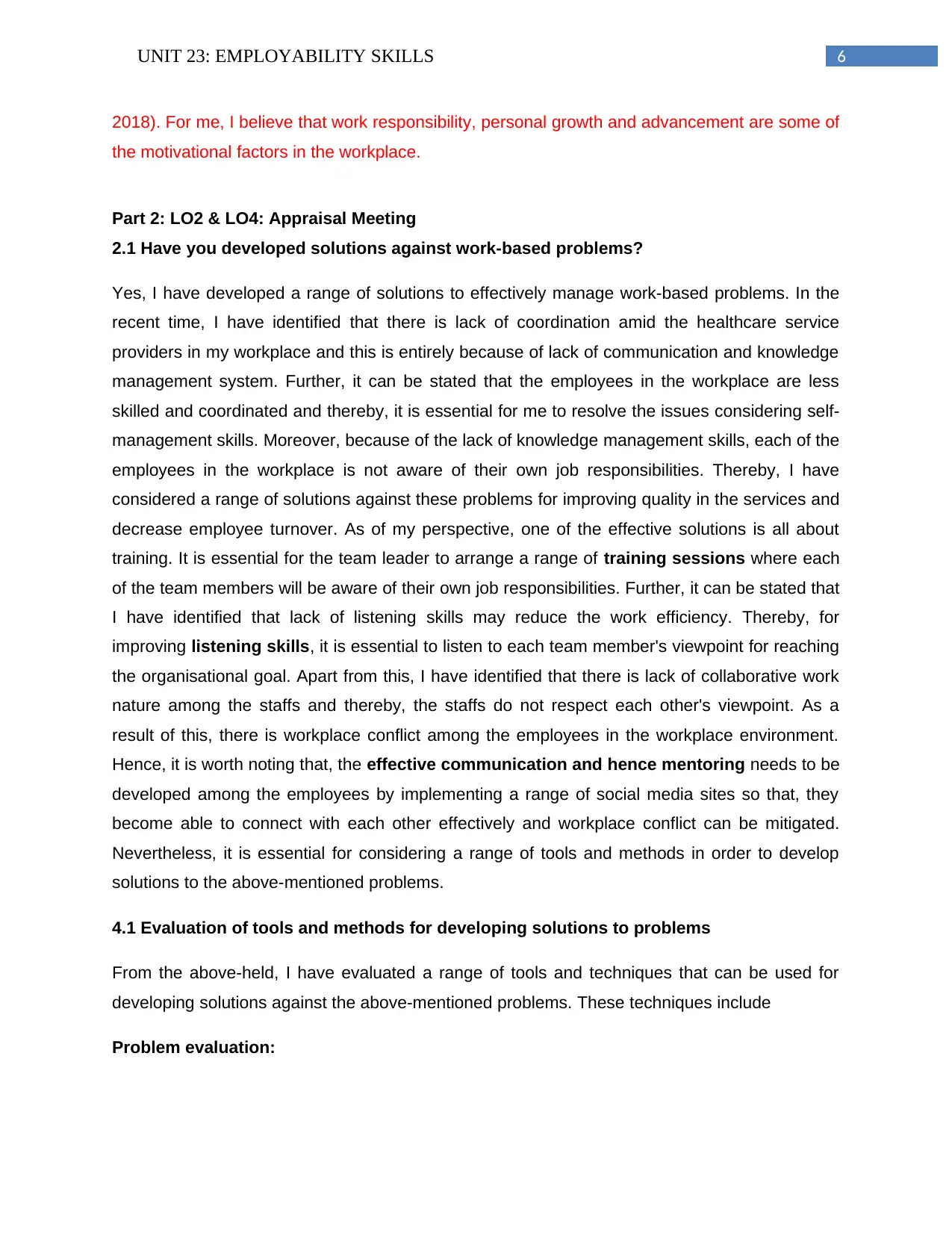
6UNIT 23: EMPLOYABILITY SKILLS
2018). For me, I believe that work responsibility, personal growth and advancement are some of
the motivational factors in the workplace.
Part 2: LO2 & LO4: Appraisal Meeting
2.1 Have you developed solutions against work-based problems?
Yes, I have developed a range of solutions to effectively manage work-based problems. In the
recent time, I have identified that there is lack of coordination amid the healthcare service
providers in my workplace and this is entirely because of lack of communication and knowledge
management system. Further, it can be stated that the employees in the workplace are less
skilled and coordinated and thereby, it is essential for me to resolve the issues considering self-
management skills. Moreover, because of the lack of knowledge management skills, each of the
employees in the workplace is not aware of their own job responsibilities. Thereby, I have
considered a range of solutions against these problems for improving quality in the services and
decrease employee turnover. As of my perspective, one of the effective solutions is all about
training. It is essential for the team leader to arrange a range of training sessions where each
of the team members will be aware of their own job responsibilities. Further, it can be stated that
I have identified that lack of listening skills may reduce the work efficiency. Thereby, for
improving listening skills, it is essential to listen to each team member's viewpoint for reaching
the organisational goal. Apart from this, I have identified that there is lack of collaborative work
nature among the staffs and thereby, the staffs do not respect each other's viewpoint. As a
result of this, there is workplace conflict among the employees in the workplace environment.
Hence, it is worth noting that, the effective communication and hence mentoring needs to be
developed among the employees by implementing a range of social media sites so that, they
become able to connect with each other effectively and workplace conflict can be mitigated.
Nevertheless, it is essential for considering a range of tools and methods in order to develop
solutions to the above-mentioned problems.
4.1 Evaluation of tools and methods for developing solutions to problems
From the above-held, I have evaluated a range of tools and techniques that can be used for
developing solutions against the above-mentioned problems. These techniques include
Problem evaluation:
2018). For me, I believe that work responsibility, personal growth and advancement are some of
the motivational factors in the workplace.
Part 2: LO2 & LO4: Appraisal Meeting
2.1 Have you developed solutions against work-based problems?
Yes, I have developed a range of solutions to effectively manage work-based problems. In the
recent time, I have identified that there is lack of coordination amid the healthcare service
providers in my workplace and this is entirely because of lack of communication and knowledge
management system. Further, it can be stated that the employees in the workplace are less
skilled and coordinated and thereby, it is essential for me to resolve the issues considering self-
management skills. Moreover, because of the lack of knowledge management skills, each of the
employees in the workplace is not aware of their own job responsibilities. Thereby, I have
considered a range of solutions against these problems for improving quality in the services and
decrease employee turnover. As of my perspective, one of the effective solutions is all about
training. It is essential for the team leader to arrange a range of training sessions where each
of the team members will be aware of their own job responsibilities. Further, it can be stated that
I have identified that lack of listening skills may reduce the work efficiency. Thereby, for
improving listening skills, it is essential to listen to each team member's viewpoint for reaching
the organisational goal. Apart from this, I have identified that there is lack of collaborative work
nature among the staffs and thereby, the staffs do not respect each other's viewpoint. As a
result of this, there is workplace conflict among the employees in the workplace environment.
Hence, it is worth noting that, the effective communication and hence mentoring needs to be
developed among the employees by implementing a range of social media sites so that, they
become able to connect with each other effectively and workplace conflict can be mitigated.
Nevertheless, it is essential for considering a range of tools and methods in order to develop
solutions to the above-mentioned problems.
4.1 Evaluation of tools and methods for developing solutions to problems
From the above-held, I have evaluated a range of tools and techniques that can be used for
developing solutions against the above-mentioned problems. These techniques include
Problem evaluation:
Paraphrase This Document
Need a fresh take? Get an instant paraphrase of this document with our AI Paraphraser
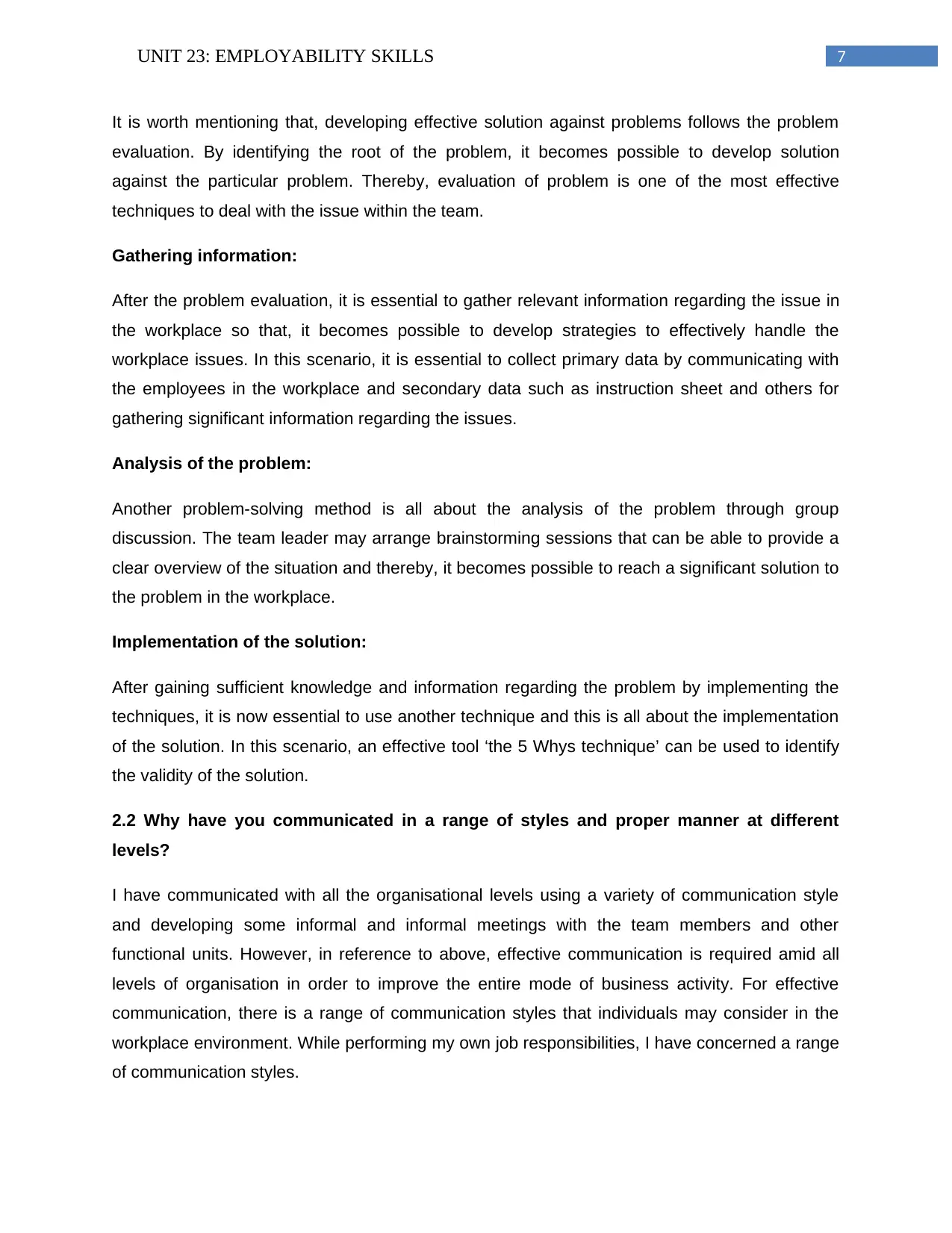
7UNIT 23: EMPLOYABILITY SKILLS
It is worth mentioning that, developing effective solution against problems follows the problem
evaluation. By identifying the root of the problem, it becomes possible to develop solution
against the particular problem. Thereby, evaluation of problem is one of the most effective
techniques to deal with the issue within the team.
Gathering information:
After the problem evaluation, it is essential to gather relevant information regarding the issue in
the workplace so that, it becomes possible to develop strategies to effectively handle the
workplace issues. In this scenario, it is essential to collect primary data by communicating with
the employees in the workplace and secondary data such as instruction sheet and others for
gathering significant information regarding the issues.
Analysis of the problem:
Another problem-solving method is all about the analysis of the problem through group
discussion. The team leader may arrange brainstorming sessions that can be able to provide a
clear overview of the situation and thereby, it becomes possible to reach a significant solution to
the problem in the workplace.
Implementation of the solution:
After gaining sufficient knowledge and information regarding the problem by implementing the
techniques, it is now essential to use another technique and this is all about the implementation
of the solution. In this scenario, an effective tool ‘the 5 Whys technique’ can be used to identify
the validity of the solution.
2.2 Why have you communicated in a range of styles and proper manner at different
levels?
I have communicated with all the organisational levels using a variety of communication style
and developing some informal and informal meetings with the team members and other
functional units. However, in reference to above, effective communication is required amid all
levels of organisation in order to improve the entire mode of business activity. For effective
communication, there is a range of communication styles that individuals may consider in the
workplace environment. While performing my own job responsibilities, I have concerned a range
of communication styles.
It is worth mentioning that, developing effective solution against problems follows the problem
evaluation. By identifying the root of the problem, it becomes possible to develop solution
against the particular problem. Thereby, evaluation of problem is one of the most effective
techniques to deal with the issue within the team.
Gathering information:
After the problem evaluation, it is essential to gather relevant information regarding the issue in
the workplace so that, it becomes possible to develop strategies to effectively handle the
workplace issues. In this scenario, it is essential to collect primary data by communicating with
the employees in the workplace and secondary data such as instruction sheet and others for
gathering significant information regarding the issues.
Analysis of the problem:
Another problem-solving method is all about the analysis of the problem through group
discussion. The team leader may arrange brainstorming sessions that can be able to provide a
clear overview of the situation and thereby, it becomes possible to reach a significant solution to
the problem in the workplace.
Implementation of the solution:
After gaining sufficient knowledge and information regarding the problem by implementing the
techniques, it is now essential to use another technique and this is all about the implementation
of the solution. In this scenario, an effective tool ‘the 5 Whys technique’ can be used to identify
the validity of the solution.
2.2 Why have you communicated in a range of styles and proper manner at different
levels?
I have communicated with all the organisational levels using a variety of communication style
and developing some informal and informal meetings with the team members and other
functional units. However, in reference to above, effective communication is required amid all
levels of organisation in order to improve the entire mode of business activity. For effective
communication, there is a range of communication styles that individuals may consider in the
workplace environment. While performing my own job responsibilities, I have concerned a range
of communication styles.
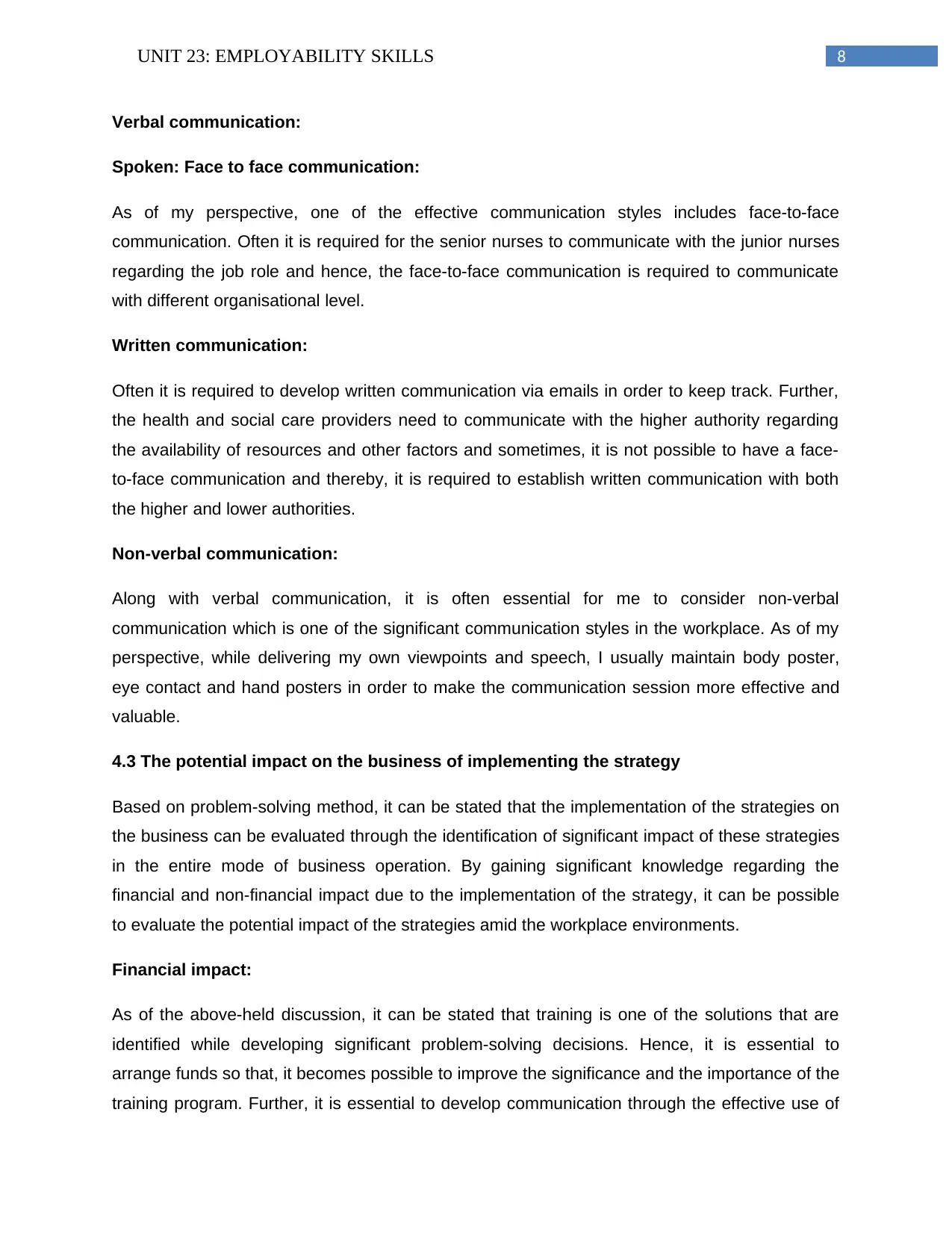
8UNIT 23: EMPLOYABILITY SKILLS
Verbal communication:
Spoken: Face to face communication:
As of my perspective, one of the effective communication styles includes face-to-face
communication. Often it is required for the senior nurses to communicate with the junior nurses
regarding the job role and hence, the face-to-face communication is required to communicate
with different organisational level.
Written communication:
Often it is required to develop written communication via emails in order to keep track. Further,
the health and social care providers need to communicate with the higher authority regarding
the availability of resources and other factors and sometimes, it is not possible to have a face-
to-face communication and thereby, it is required to establish written communication with both
the higher and lower authorities.
Non-verbal communication:
Along with verbal communication, it is often essential for me to consider non-verbal
communication which is one of the significant communication styles in the workplace. As of my
perspective, while delivering my own viewpoints and speech, I usually maintain body poster,
eye contact and hand posters in order to make the communication session more effective and
valuable.
4.3 The potential impact on the business of implementing the strategy
Based on problem-solving method, it can be stated that the implementation of the strategies on
the business can be evaluated through the identification of significant impact of these strategies
in the entire mode of business operation. By gaining significant knowledge regarding the
financial and non-financial impact due to the implementation of the strategy, it can be possible
to evaluate the potential impact of the strategies amid the workplace environments.
Financial impact:
As of the above-held discussion, it can be stated that training is one of the solutions that are
identified while developing significant problem-solving decisions. Hence, it is essential to
arrange funds so that, it becomes possible to improve the significance and the importance of the
training program. Further, it is essential to develop communication through the effective use of
Verbal communication:
Spoken: Face to face communication:
As of my perspective, one of the effective communication styles includes face-to-face
communication. Often it is required for the senior nurses to communicate with the junior nurses
regarding the job role and hence, the face-to-face communication is required to communicate
with different organisational level.
Written communication:
Often it is required to develop written communication via emails in order to keep track. Further,
the health and social care providers need to communicate with the higher authority regarding
the availability of resources and other factors and sometimes, it is not possible to have a face-
to-face communication and thereby, it is required to establish written communication with both
the higher and lower authorities.
Non-verbal communication:
Along with verbal communication, it is often essential for me to consider non-verbal
communication which is one of the significant communication styles in the workplace. As of my
perspective, while delivering my own viewpoints and speech, I usually maintain body poster,
eye contact and hand posters in order to make the communication session more effective and
valuable.
4.3 The potential impact on the business of implementing the strategy
Based on problem-solving method, it can be stated that the implementation of the strategies on
the business can be evaluated through the identification of significant impact of these strategies
in the entire mode of business operation. By gaining significant knowledge regarding the
financial and non-financial impact due to the implementation of the strategy, it can be possible
to evaluate the potential impact of the strategies amid the workplace environments.
Financial impact:
As of the above-held discussion, it can be stated that training is one of the solutions that are
identified while developing significant problem-solving decisions. Hence, it is essential to
arrange funds so that, it becomes possible to improve the significance and the importance of the
training program. Further, it is essential to develop communication through the effective use of
⊘ This is a preview!⊘
Do you want full access?
Subscribe today to unlock all pages.

Trusted by 1+ million students worldwide
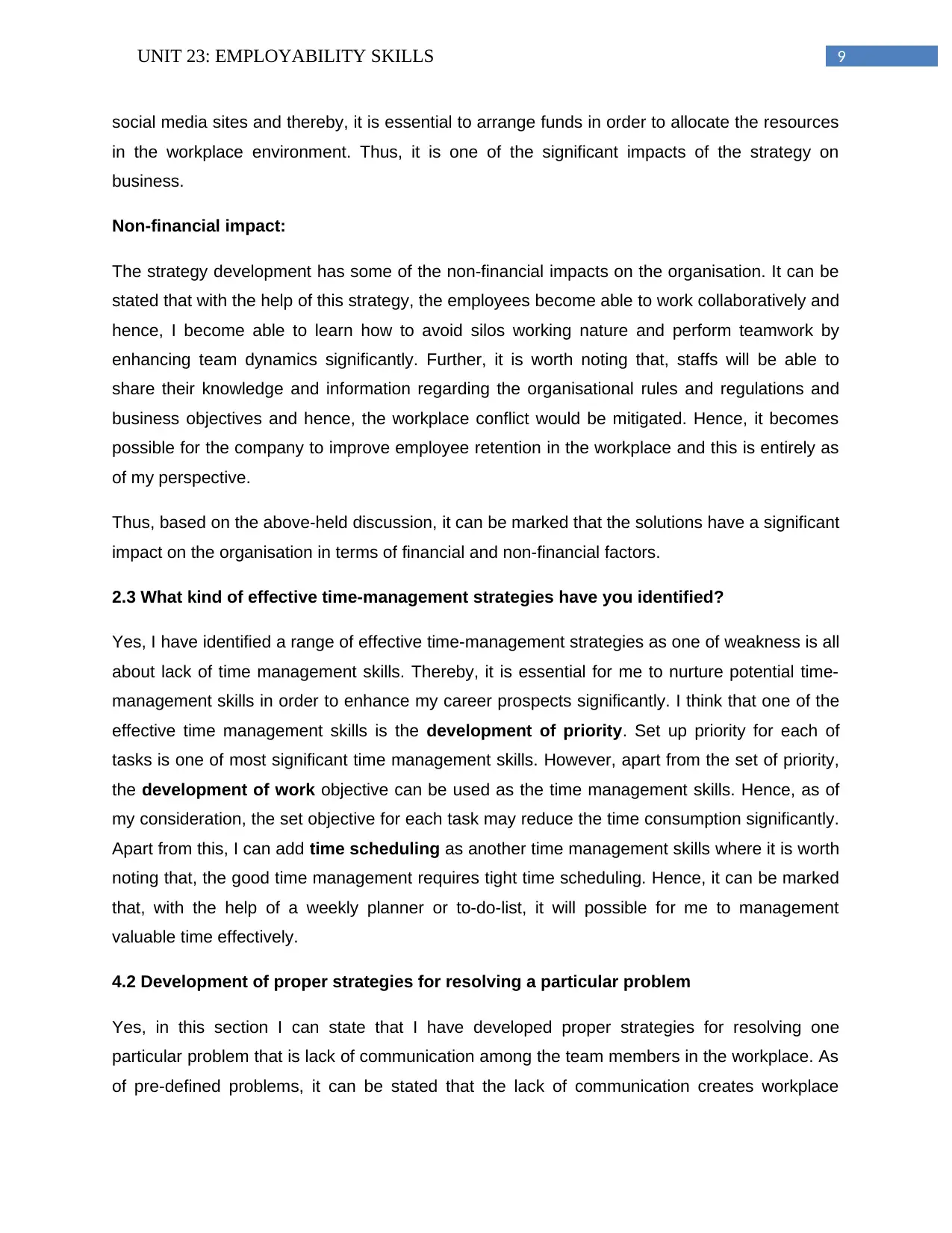
9UNIT 23: EMPLOYABILITY SKILLS
social media sites and thereby, it is essential to arrange funds in order to allocate the resources
in the workplace environment. Thus, it is one of the significant impacts of the strategy on
business.
Non-financial impact:
The strategy development has some of the non-financial impacts on the organisation. It can be
stated that with the help of this strategy, the employees become able to work collaboratively and
hence, I become able to learn how to avoid silos working nature and perform teamwork by
enhancing team dynamics significantly. Further, it is worth noting that, staffs will be able to
share their knowledge and information regarding the organisational rules and regulations and
business objectives and hence, the workplace conflict would be mitigated. Hence, it becomes
possible for the company to improve employee retention in the workplace and this is entirely as
of my perspective.
Thus, based on the above-held discussion, it can be marked that the solutions have a significant
impact on the organisation in terms of financial and non-financial factors.
2.3 What kind of effective time-management strategies have you identified?
Yes, I have identified a range of effective time-management strategies as one of weakness is all
about lack of time management skills. Thereby, it is essential for me to nurture potential time-
management skills in order to enhance my career prospects significantly. I think that one of the
effective time management skills is the development of priority. Set up priority for each of
tasks is one of most significant time management skills. However, apart from the set of priority,
the development of work objective can be used as the time management skills. Hence, as of
my consideration, the set objective for each task may reduce the time consumption significantly.
Apart from this, I can add time scheduling as another time management skills where it is worth
noting that, the good time management requires tight time scheduling. Hence, it can be marked
that, with the help of a weekly planner or to-do-list, it will possible for me to management
valuable time effectively.
4.2 Development of proper strategies for resolving a particular problem
Yes, in this section I can state that I have developed proper strategies for resolving one
particular problem that is lack of communication among the team members in the workplace. As
of pre-defined problems, it can be stated that the lack of communication creates workplace
social media sites and thereby, it is essential to arrange funds in order to allocate the resources
in the workplace environment. Thus, it is one of the significant impacts of the strategy on
business.
Non-financial impact:
The strategy development has some of the non-financial impacts on the organisation. It can be
stated that with the help of this strategy, the employees become able to work collaboratively and
hence, I become able to learn how to avoid silos working nature and perform teamwork by
enhancing team dynamics significantly. Further, it is worth noting that, staffs will be able to
share their knowledge and information regarding the organisational rules and regulations and
business objectives and hence, the workplace conflict would be mitigated. Hence, it becomes
possible for the company to improve employee retention in the workplace and this is entirely as
of my perspective.
Thus, based on the above-held discussion, it can be marked that the solutions have a significant
impact on the organisation in terms of financial and non-financial factors.
2.3 What kind of effective time-management strategies have you identified?
Yes, I have identified a range of effective time-management strategies as one of weakness is all
about lack of time management skills. Thereby, it is essential for me to nurture potential time-
management skills in order to enhance my career prospects significantly. I think that one of the
effective time management skills is the development of priority. Set up priority for each of
tasks is one of most significant time management skills. However, apart from the set of priority,
the development of work objective can be used as the time management skills. Hence, as of
my consideration, the set objective for each task may reduce the time consumption significantly.
Apart from this, I can add time scheduling as another time management skills where it is worth
noting that, the good time management requires tight time scheduling. Hence, it can be marked
that, with the help of a weekly planner or to-do-list, it will possible for me to management
valuable time effectively.
4.2 Development of proper strategies for resolving a particular problem
Yes, in this section I can state that I have developed proper strategies for resolving one
particular problem that is lack of communication among the team members in the workplace. As
of pre-defined problems, it can be stated that the lack of communication creates workplace
Paraphrase This Document
Need a fresh take? Get an instant paraphrase of this document with our AI Paraphraser
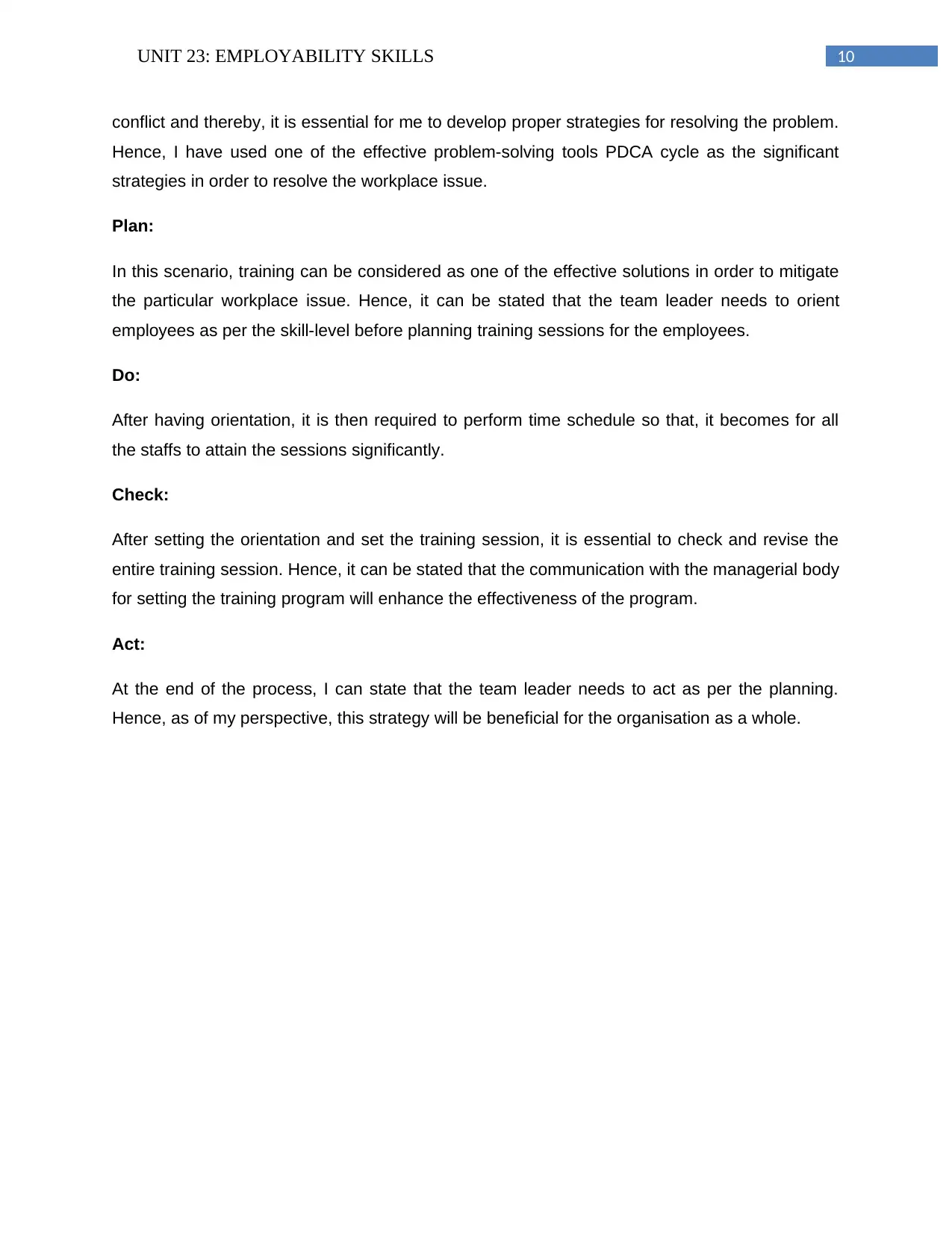
10UNIT 23: EMPLOYABILITY SKILLS
conflict and thereby, it is essential for me to develop proper strategies for resolving the problem.
Hence, I have used one of the effective problem-solving tools PDCA cycle as the significant
strategies in order to resolve the workplace issue.
Plan:
In this scenario, training can be considered as one of the effective solutions in order to mitigate
the particular workplace issue. Hence, it can be stated that the team leader needs to orient
employees as per the skill-level before planning training sessions for the employees.
Do:
After having orientation, it is then required to perform time schedule so that, it becomes for all
the staffs to attain the sessions significantly.
Check:
After setting the orientation and set the training session, it is essential to check and revise the
entire training session. Hence, it can be stated that the communication with the managerial body
for setting the training program will enhance the effectiveness of the program.
Act:
At the end of the process, I can state that the team leader needs to act as per the planning.
Hence, as of my perspective, this strategy will be beneficial for the organisation as a whole.
conflict and thereby, it is essential for me to develop proper strategies for resolving the problem.
Hence, I have used one of the effective problem-solving tools PDCA cycle as the significant
strategies in order to resolve the workplace issue.
Plan:
In this scenario, training can be considered as one of the effective solutions in order to mitigate
the particular workplace issue. Hence, it can be stated that the team leader needs to orient
employees as per the skill-level before planning training sessions for the employees.
Do:
After having orientation, it is then required to perform time schedule so that, it becomes for all
the staffs to attain the sessions significantly.
Check:
After setting the orientation and set the training session, it is essential to check and revise the
entire training session. Hence, it can be stated that the communication with the managerial body
for setting the training program will enhance the effectiveness of the program.
Act:
At the end of the process, I can state that the team leader needs to act as per the planning.
Hence, as of my perspective, this strategy will be beneficial for the organisation as a whole.
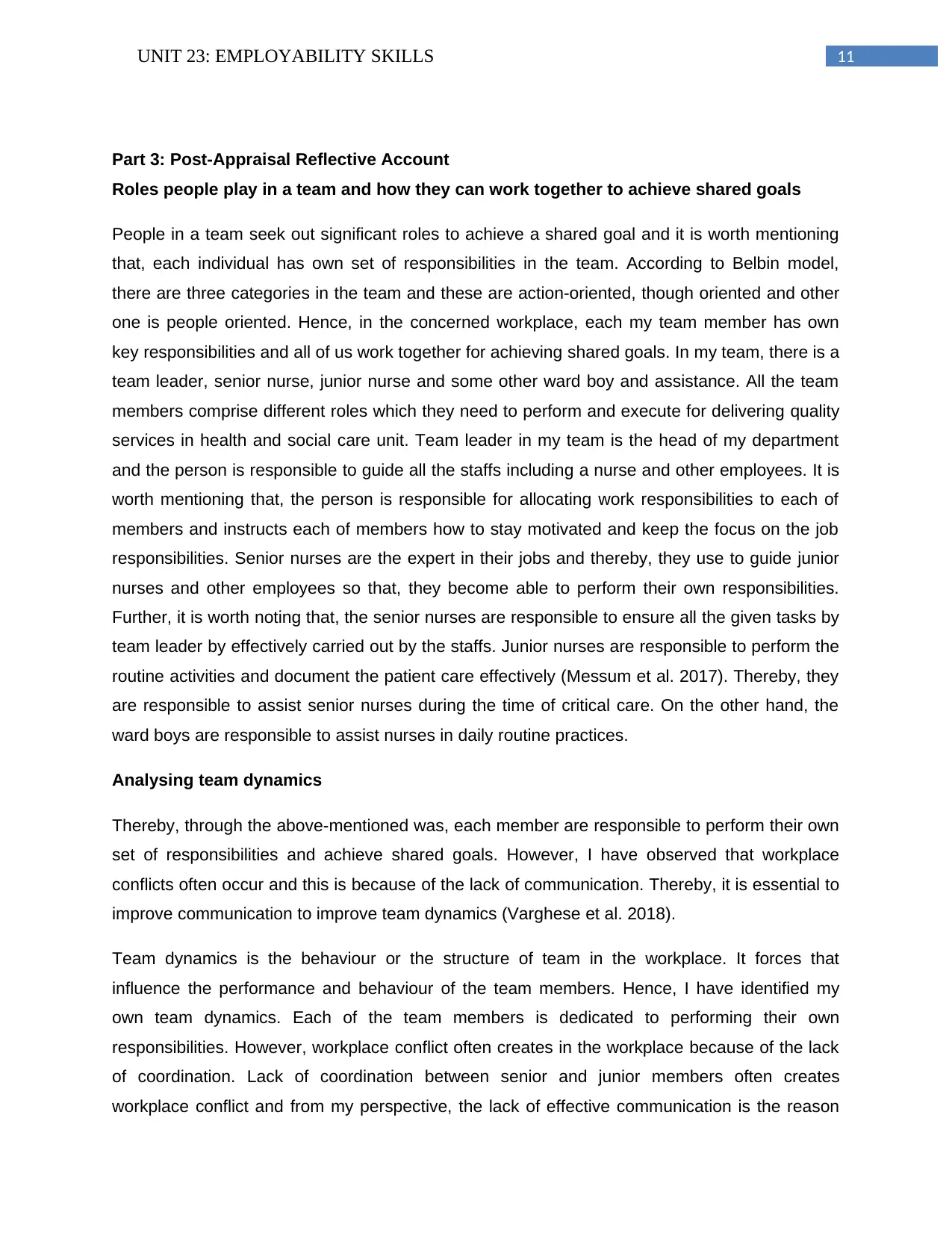
11UNIT 23: EMPLOYABILITY SKILLS
Part 3: Post-Appraisal Reflective Account
Roles people play in a team and how they can work together to achieve shared goals
People in a team seek out significant roles to achieve a shared goal and it is worth mentioning
that, each individual has own set of responsibilities in the team. According to Belbin model,
there are three categories in the team and these are action-oriented, though oriented and other
one is people oriented. Hence, in the concerned workplace, each my team member has own
key responsibilities and all of us work together for achieving shared goals. In my team, there is a
team leader, senior nurse, junior nurse and some other ward boy and assistance. All the team
members comprise different roles which they need to perform and execute for delivering quality
services in health and social care unit. Team leader in my team is the head of my department
and the person is responsible to guide all the staffs including a nurse and other employees. It is
worth mentioning that, the person is responsible for allocating work responsibilities to each of
members and instructs each of members how to stay motivated and keep the focus on the job
responsibilities. Senior nurses are the expert in their jobs and thereby, they use to guide junior
nurses and other employees so that, they become able to perform their own responsibilities.
Further, it is worth noting that, the senior nurses are responsible to ensure all the given tasks by
team leader by effectively carried out by the staffs. Junior nurses are responsible to perform the
routine activities and document the patient care effectively (Messum et al. 2017). Thereby, they
are responsible to assist senior nurses during the time of critical care. On the other hand, the
ward boys are responsible to assist nurses in daily routine practices.
Analysing team dynamics
Thereby, through the above-mentioned was, each member are responsible to perform their own
set of responsibilities and achieve shared goals. However, I have observed that workplace
conflicts often occur and this is because of the lack of communication. Thereby, it is essential to
improve communication to improve team dynamics (Varghese et al. 2018).
Team dynamics is the behaviour or the structure of team in the workplace. It forces that
influence the performance and behaviour of the team members. Hence, I have identified my
own team dynamics. Each of the team members is dedicated to performing their own
responsibilities. However, workplace conflict often creates in the workplace because of the lack
of coordination. Lack of coordination between senior and junior members often creates
workplace conflict and from my perspective, the lack of effective communication is the reason
Part 3: Post-Appraisal Reflective Account
Roles people play in a team and how they can work together to achieve shared goals
People in a team seek out significant roles to achieve a shared goal and it is worth mentioning
that, each individual has own set of responsibilities in the team. According to Belbin model,
there are three categories in the team and these are action-oriented, though oriented and other
one is people oriented. Hence, in the concerned workplace, each my team member has own
key responsibilities and all of us work together for achieving shared goals. In my team, there is a
team leader, senior nurse, junior nurse and some other ward boy and assistance. All the team
members comprise different roles which they need to perform and execute for delivering quality
services in health and social care unit. Team leader in my team is the head of my department
and the person is responsible to guide all the staffs including a nurse and other employees. It is
worth mentioning that, the person is responsible for allocating work responsibilities to each of
members and instructs each of members how to stay motivated and keep the focus on the job
responsibilities. Senior nurses are the expert in their jobs and thereby, they use to guide junior
nurses and other employees so that, they become able to perform their own responsibilities.
Further, it is worth noting that, the senior nurses are responsible to ensure all the given tasks by
team leader by effectively carried out by the staffs. Junior nurses are responsible to perform the
routine activities and document the patient care effectively (Messum et al. 2017). Thereby, they
are responsible to assist senior nurses during the time of critical care. On the other hand, the
ward boys are responsible to assist nurses in daily routine practices.
Analysing team dynamics
Thereby, through the above-mentioned was, each member are responsible to perform their own
set of responsibilities and achieve shared goals. However, I have observed that workplace
conflicts often occur and this is because of the lack of communication. Thereby, it is essential to
improve communication to improve team dynamics (Varghese et al. 2018).
Team dynamics is the behaviour or the structure of team in the workplace. It forces that
influence the performance and behaviour of the team members. Hence, I have identified my
own team dynamics. Each of the team members is dedicated to performing their own
responsibilities. However, workplace conflict often creates in the workplace because of the lack
of coordination. Lack of coordination between senior and junior members often creates
workplace conflict and from my perspective, the lack of effective communication is the reason
⊘ This is a preview!⊘
Do you want full access?
Subscribe today to unlock all pages.

Trusted by 1+ million students worldwide
1 out of 15
Related Documents
Your All-in-One AI-Powered Toolkit for Academic Success.
+13062052269
info@desklib.com
Available 24*7 on WhatsApp / Email
![[object Object]](/_next/static/media/star-bottom.7253800d.svg)
Unlock your academic potential
Copyright © 2020–2025 A2Z Services. All Rights Reserved. Developed and managed by ZUCOL.



